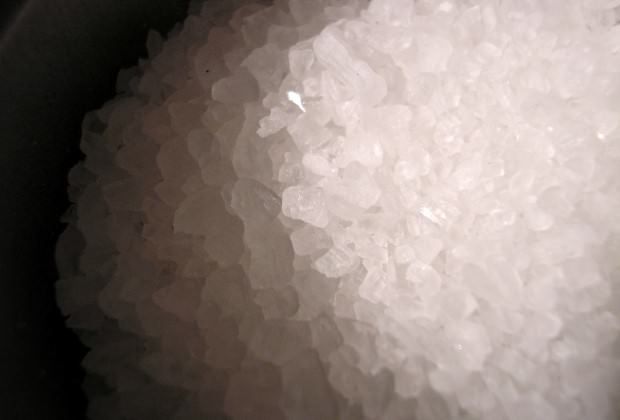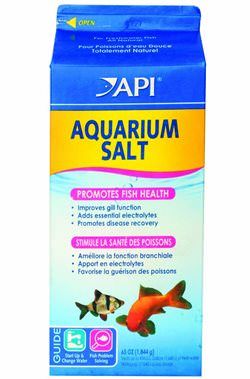
How much salt do you need to keep your goldfish alive and paddling?
It depends on what you’re using the salt for. If you want to prevent goldfish diseases, you won’t need much of it. But if you’re treating goldfish parasites, you might consider a salt bath.
Don’t worry if this all sounds confusing. We’ll walk through it, step by step.
First, we’ll compare different methods on how to use aquarium salt. Then we’ll determine the aquarium salt treatment that’s right for your tank.
Let’s dive in.
Aquarium Salt Treatment #1: Keep Your Tank Salted at All Times
Maintaining a low level of salt in your tank not only treats ugly goldfish diseases.
It prevents them.
An aquarium salt treatment can also be used regularly to reduce goldfish stress and stimulate slime coat production. Plus, salt can kill off parasites harmful to goldfish, nipping one problem in the bud!
How to Use Aquarium Salt Regularly
You don’t need a lot of salt for it to be effective. In fact, I recommend using very little aquarium salt as a preventative.
Let’s take a look at how to use aquarium salt, whether or not you’re treating infections.
- When preventing goldfish diseases: Add ½ teaspoon (or less!) for every gallon (about 4 liters) in your aquarium. After a partial water change, treat the amount of water you took out of the tank.
- When reducing stress or treating parasites: Add 1 tablespoon (3 teaspoons) for every 5 gallons (19 liters) of aquarium water. If you’re performing a partial water change, only add the correct amount of salt to water taken out.
The higher the dosage, the more concentrated the salt.
When you’re dealing with parasites, you’ll want salt concentrations to be slightly higher than your routine salt treatments. The higher concentration makes the aquarium salt treatment more effective.
This means that killing off icky parasites will be much easier. And at the same time, you’re not stressing out your poor goldfish with the increased salt concentration.
But never add salt when topping off the goldfish tank (replacing evaporated water).
Salt doesn’t evaporate, so you’d be adding more salt than your goldfish need. Too much of an aquarium salt treatment can be very stressful. Only add salt with every water change (and only for the amount of water you took out).
But watch out! This type of treatment does have its drawbacks.
Pitfalls of a Routine Aquarium Salt Treatment
While adding salt regularly can help prevent goldfish diseases, you might run into a few problems.
- Using salt as a preventative can make parasites resistant to salt treatments. So if your goldfish get sick, you may have to stick to medications instead.
- By adding salt all of the time, your goldfish are constantly producing extra slime. This can be as uncomfortable as wearing an extra jacket during the winter season, even if you’re guarding against cold. Salt also acts as an irritant (that’s how it thickens the slime coat!).
- Salt and aquatic plants don’t mix. And some plants simply don’t tolerate salt well. Even so, most plants should do fine with a little bit of aquarium salt.
- A regular dosage can reverse the effects of zeolite (filter media that removes ammonia). Sure, salt recharges zeolite (but only by making it release all of that pent-up ammonia it had absorbed). So if you’re using zeolite in your filter, remove it before an aquarium salt treatment.
With so many disadvantages, should you even add salt regularly?
If you’re maintaining healthy conditions in your aquarium, your goldfish aren’t likely to get sick in the first place. So you wouldn’t really need to use salt as a preventative.
But it’s up to you. This type of aquarium salt treatment might be useful if you’re keeping goldfish in uncomfortable conditions temporarily. It will help prevent infections until you can move your goldfish to their primary home.
If you prefer only to use salt when your goldfish are sick, there’s a better method. It’s called the salt dip.
Aquarium Salt Treatment #2: Only Treat Your Tank When Needed
One school of thought is that salt doesn’t belong in tanks at all times.
Instead, many aquarists like to use salt only to treat stress and parasites – when there are symptoms. Aquarium salt can also be used in emergency situations, when nitrite levels are at their peak. And it’s particularly effective in quarantine and hospital tanks.
You can either add salt directly into the aquarium (1 tablespoon or 3 teaspoons per 5 gallons) or perform a salt dip (a short-term salt bath).
Below, we’ll talk about the latter – how to give your goldfish a salt bath. But first, you’ll want to set up a hospital or quarantine tank your goldfish will stay in until you’ve eradicated all parasites in the main aquarium.
Already have a quarantine tank up and running? Great! Let’s move on to the next step…
How to Use Aquarium Salt in a Salt Dip to Treat Infections
Doing a salt dip is actually pretty easy (even though the very idea may be a bit scary!).
By exposing your goldfish to salt temporarily, you can quickly eradicate parasites. And all you need is a 5-gallon bucket or tank with a working airstone (make sure to attach it to the appropriate air pump), some aquarium water, and the salt of course!
How to use aquarium salt in a salt dip? Let’s walk through the steps.
- Fill a bucket with aquarium water (remember how many gallons that bucket can hold). Make sure it has the same temperature and pH as your tank water. You don’t want to shock your goldfish!
- Mix the salt solution. Pour in 30 teaspoons of non-iodized salt for every gallon (4 liters) of water (source). Stir the solution until the salt is dissolved.
- Gently scoop your goldfish into the aquarium salt treatment. Wait five minutes, observing how your goldfish react to the water. If your goldfish act a bit odd, that’s normal. But if they roll over or rest to the side and can’t right themselves, return them to the quarantine tank (you may have to use the former salt treatment method or medicate instead). If all is well and your goldfish continue to swim upright, keep up treatment for 55 minutes more or up to a total of 2 hours (source).
- Move your goldfish to a quarantine tank. This tank should have the same temperature and pH levels as the aquarium salt treatment. Ideally, you’ll want to use a fully-cycled 20-gallon aquarium (for one or two goldfish). But for a single goldfish, a 10-gallon quarantine tank may work as well.
- Treat the primary aquarium to get rid of any remaining parasites. You can use salt or a medication for this. Once you’re sure that you’ve killed off all parasites (this will depend on the parasite life cycle), you can re-introduce (acclimate) your goldfish to their now parasite-free environment.
A salt dip can head off potentially nasty infections, deteriorating slime coats, painful wounds, and a bulk of other problems. But because salt doesn’t evaporate, you should remove the aquarium salt treatment with a series of water changes once you’ve killed the parasites.
One Disadvantage of a Salt Dip: It Can Be Stressful!
Luckily, your goldfish won’t stay in the salt solution for very long. And by the time you’re done with treatment, your goldfish should be parasite free!
But during the aquarium salt treatment, keep an eye on your goldfish.
If your goldfish aren’t responsive, give them a soft pat to get them moving. If even that doesn’t work, remove your fish from the aquarium salt treatment right away. Some goldfish diseases can take a toll on fish – and your goldfish might be too weak for the salt dip.
Of course, you’ll still need to treat the entire aquarium after the salt dip. So keep your goldfish in a quarantine tank until you’ve exterminated every last parasite.
Which Method Is More Effective?
You’ve learned how to use aquarium salt. But which aquarium salt treatment is your best bet?
Choose the option that makes the most sense to you.
Many goldfish hobbyists recommend using a salt dip when necessary, but adding salt to your aquarium regularly can reduce stress when goldfish are already in an uncomfortable environment.
But while salt can be a good preventative, you also want the immune system to keep running strong (and regularly putting salt in the tank can make parasites more immune to the salt, especially if you don’t change concentrations).
Regardless of which choice you make, stay away from salts with additives!
The extra stuff in table salt can be harmful. Special aquarium salt (designed for freshwater fish), non-iodized rock salt, or kosher salt is generally what you will want to work with.
Anything else might endanger your aquatic friends – and that’s the opposite of what you want an aquarium salt treatment to do.
Your Turn: How Do You Use Aquarium Salt?
What to do you think? Should you add salt regularly or only when you need it? What’s your preferred method of treatment?
Post your thoughts in the comment section below!





15 comments
Can an 800 Gal Stock tank be treated with salt? Will it harm water iris? Will it harm pond lilies? Do I still use 1 tablespoon or 3 teaspoons per 5 gallons in my 800 gal tank with many baby goldfish in it that have ick?
Hi i am in the process of setting an aquariam for goldfish, it has a external fitler and contains 151 liters of water, do i add aquarium salt to the water before any fish are put in the tank or do i put salt in with the fish ? and if so now much would you recommend.
Regards Mike Maynard
How long should my goldfish stay in the salt bath? It has an infection & I’m really worried.
Your information is excellent but I have a fish with tiny red spots almost like tiny bubbles on fins, edge of gills. Any idea? I am using melafix and just used salt today. 55 gal, comet goldfish is the ill one and shubunkin is sitting on bottom of tank, All test show tank is good.
this was no help if somebody could e-mail me I would greatly apprieceat it my fish is not new to tank but I got up this morning and she is staying close to top of tank, breathing though mouth and gills, hardly moving at all , when I took her out of tank it took her a little while to start to react. I have removed her from big tank and put her into smaller one by herself. please help me!!!
This article was very helpful. I was especially interested in what was stated about carbon filters that contain zeolite. Can you recommend a good filter cartridge that does not contain zeolite that I can use regularly?
Hi Jaime,
Commercial filter cartridges don’t usually contain zeolite (from my experience). You’d need to buy zeolite filter media separately if you wanted to use it to remove ammonia. The commercial filter cartridges you’ll find that contain activated carbon should be fine to use with salt.
If you’re looking for new filter media to try if you want to build your own filter media bag, I’ve had great results with Seachem Matrix mixed with activated carbon and Seachem Purigen.
Glad you found the article helpful! Let me know if you need anything else cleared up.
I saw two weird white spots on my fish that reminded me of ich so I added aquarium salt and then a few hours after the spots fell off I decided to do a salt dip. It was my biggest fantail goldfish. Anyway, he lasted 5 minutes in the dip and I put him back in the main tank. He was fine last night and today, but then when I just checked (it’s been about 6 hours since I last looked at him) part of his caudal fins are jagged like they were eaten away. Apparently I guessed right and he did have sometihng on him. I was not expecting his fins to be damaged that much later after the dip and after the stuff had fallen off him. Will continue treaatment and see how it goes and report later. Thanks.
Hi Dee,
How is your goldfish doing?
What you’re describing sounds like a case of fin rot, a bacterial infection that affects goldfish when they’re under a lot of stress (probably from the white spots you mentioned earlier in the comment).
As for the white spots, if they resemble grains of salt, they’re probably ich parasites (you can read more about treating ich in my white spot disease article here). When curing your goldfish from ich, you’ll want to follow a salt and heat treatment, since higher temperatures (combined with the salt) are pretty effective at killing off the parasites.
However, if the white spots look fuzzy, your goldfish is probably facing some type of fungal infection.
Before jumping on any treatment plan, you should test the water for ammonia, nitrite, and nitrate – make sure all levels are healthy. Ammonia and nitrite should remain at 0ppm (parts per million) in an established tank white nitrates should be below 40ppm (though, you should try to keep nitrates even lower at 20ppm or below if possible). You can read more about this in my water parameter guide.
If you can keep water conditions healthy, your goldfish will have a better chance at recovery. Maintaining good water quality should also help improve the fin rot, since stress is a huge contributor.
Let me know how your goldfish is doing and if there’s anything I can help you with!
THANKS FOR YOUR HELPFUL INFO ON USING SALT TO TREAT GOLDFISH DISEASE!
You’re welcome, Janet! I’m so glad this article has helped you!
Hi
I’m just looking for some clarification on the above advice.
In Step 5, you say “Once you’re sure that you’ve killed off all parasites, you can re-introduce (acclimate) your goldfish to their now parasite-free environment”.
My question is: How can you be sure that you’ve killed off all parasites? Am I meant to be looking for anything in particular? Is it safe to assume that all parasites will be killed off within a particular period of time of salt dosing (e.g. 5 mins/10 mins)?
Thanks in advance.
Hi Claire,
Sorry for the confusion! If you’re giving your goldfish a salt dip, you’ll want to carefully monitor your goldfish’s behavior. The treatment itself generally lasts 1-2 hours, but if your goldfish falls over in the salt solution, your goldfish is probably too weak from infection for the salt dip and you’ll either want to add a gentler salt solution (1 tablespoon or 3 teaspoons per 5 gallons) to the entire tank for a period of time or treat the tank (and goldfish) with the appropriate medication.
Now, if the salt dip is successful, you should keep your goldfish in a cycled quarantine tank with fresh water until the main aquarium is parasite free. How long that takes will depend on the life cycle of the parasite. For example, treating ich can take 15 days or more depending on water temperature.
Keep in mind that salt doesn’t kill all parasites. For example, gill or skin flukes are generally resistant to salt treatments and will need something gentle (for fish, that is) like Praziquantel.
My comet goldfish is 16 years old. She has gone into a curled position,which seems to be like a paralysis. I’ve changed her 20 gal tank with tap water, once a week, 25% and used Aqua Safe, one full cap. Used Aquarium salt one and 1/2 teaspoon. She will only eat peas, so I feed her 4-6 (from frozen peas), I shell the outer layer and, running them under tap water…I serve them to her. Now at this time it’s been recommended to fast a few days…but she’s been begging me to feed her, so I gave her one or two. She’s making an improvement after the 4th day. I thought I lost her, but she’s a good little fighter. She’s still on her side, but is swimming up and tries to stay there. Of course I’ve changed the filters and scrubbed the insides real good, and used a small net to catch anything I’ve missed with the suction pump (I forget the name for it). I think more good internet “how to take care of your fish..” would be advisable. Thank you very much for all your good advise. Merry Christmas from Ms Hayley Peabody and me.
Hi Gary,
I’m so sorry to hear your poor comet goldfish is sick. I am happy that she’s starting to feel better – even if it’s just a slight improvement.
Have you tried testing the water for ammonia and nitrite recently? If we can pinpoint what caused your goldfish to get sick, it might help her recover. It is good that you’re providing fresh water every week. Just when you’re cleaning out the filter, be careful not to disturb the beneficial bacteria that are living in the filter media – you don’t want the nitrogen cycle to reset, especially when your goldfish is already so sick!
Let me know once you have a chance to get those water readings. I really hope she starts feeling better soon!